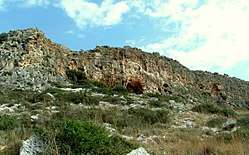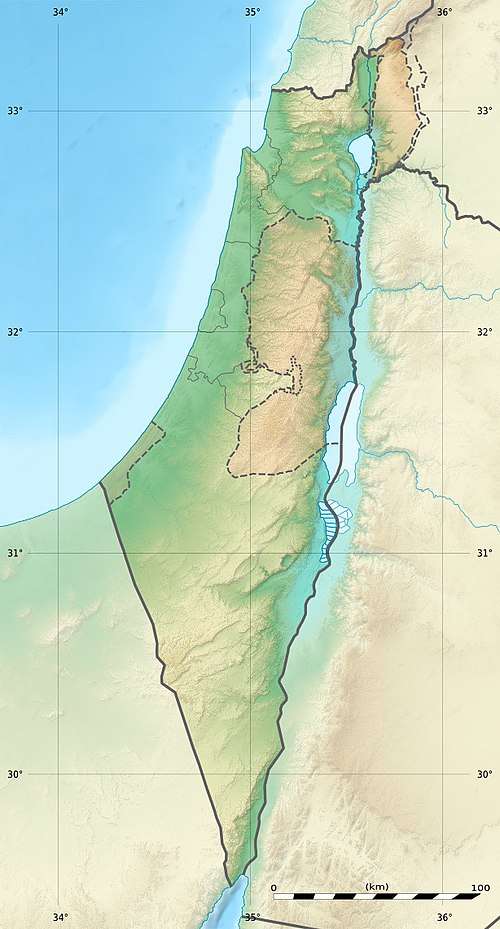Misliya cave
Misliya cave (Hebrew: מערת מיסליה), also known as Brotzen Cave after Fritz Brotzen who first described it in 1927, is a collapsed cave at Mount Carmel, Israel, containing archaeological layers from the Lower Paleolithic and Middle Paleolithic periods. The site is significant in paleoanthropology for the discovery of what were, from 2018 to 2019, considered to be the earliest known remains attributed to Homo sapiens outside of Africa, dated to 185,000 years ago[1] (in 2019 even older Homo sapiens remains were identified in Greece).[2]
 | |
 Location in Israel | |
| Location | Mount Carmel, Israel |
|---|---|
| Coordinates | |
| Length | 80 m (262 ft) |
Excavations by teams of University of Haifa and University of Tel Aviv were conducted in the 2000/1 season, yielding finds dated to between 300,000 and 150,000 years ago.[3]
Of special interest is the Misliya-1 fossil, an upper jawbone discovered in 2002[4] and at first dated to "possibly 150,000 years ago" and classified as "early modern Homo sapiens" (EMHS).[5] In January 2018, the date of the fossil has been revised to between 177,000 and 194,000 years ago (95% CI).[6][7] This qualifies Misliya-1 as one of the oldest known fossil of H. sapiens, of comparable age to the Omo remains (identified as "archaic Homo sapiens", or Homo sapiens idaltu),[8] and the oldest modern humans ever found outside of Africa.[1]
See also
| Wikimedia Commons has media related to Misliya Cave. |
- Anatomically modern humans
- List of human evolution fossils
- Northern Dispersal
- Recent African origin of modern humans
References
- Israeli fossils are the oldest modern human ever found outside of Africa. Auf: Nature News 25 January 2018
- Apidima Cave fossils provide earliest evidence of Homo sapiens in Eurasia, by Katerina Harvati et al. Nature (2019), online since 10 July 2019.
- Valladas, H., Mercier, N., Hershkovitz, I., Zaidner, Y., Tsatskin, A., Yeshurun, R., Vialettes, L., Joron, J.L., Reyss, J.L. and Weinstein-Evron, M., 2013. Dating the Lower to Middle Paleolithic transition in the Levant: A view from Misliya Cave, Mount Carmel, Israel. Journal of human evolution, 65(5), pp.585-593.
- Jawbone fossil found in Israeli cave resets clock for modern human evolution. Amanda Borschel-Dan, The Times Of Israel. 25 January 2018.
- Human exodus may have reached China 100,000 years ago. (2014)
- Herschkovitz, Israel; et al. (26 January 2018). "The earliest modern humans outside Africa". Science. 359 (6374): 456–459. doi:10.1126/science.aap8369. PMID 29371468.
- St. Fleur, Nicholas (25 January 2018). "In Cave in Israel, Scientists Find Jawbone Fossil From Oldest Modern Human Out of Africa". The New York Times. Retrieved 30 June 2018.
- When did modern humans leave Africa? Auf: sciencemag.org vom 26. Januar 2018
External links
- Mina Weinstein-Evron et al.: Introducing Misliya Cave, Mount Carmel, Israel: A new continuous Lower/Middle Paleolithic sequence in the Levant. In: Eurasian Prehistory. Band 1, Nr. 1, 2003, S. 31–55.
- Mina Weinstein-Evron et al.: A Window into Early Middle Paleolithic Human Occupational Layers: Misliya Cave, Mount Carmel, Israel. In: Paleo Anthropology. 2012: 202−228, doi:10.4207/PA.2012.ART75
- Hélène Valladas, Norbert Mercier, Israel Hershkovitz et al.: Dating the Lower to Middle Paleolithic transition in the Levant: A view from Misliya Cave, Mount Carmel, Israel. In: Journal of Human Evolution. Band 65, Nr. 5, 2013, S. 585–593, doi:10.1016/j.jhevol.2013.07.005